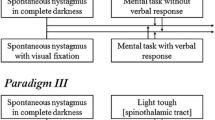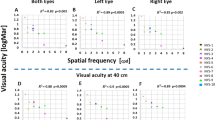Summary
A study of optokinetic nystagmus (OKN) as produced by monocular or binocular stimulation was carried out in the pigeon. Nystagmus was provoked by constant speed rotation (13 or 36 °/s) of an optokinetic drum lined with alternate black and white vertical stripes. With the animal's head immobilized, the electro-oculogram of each eye was recorded for both directions of rotation.
-
I.
Depending on the response to monocular stimulation, the animals were put into three categories: (1) no nystagmus was detected in either eye, (2) nystagmus was found in the stimulated eye only, (3) both eyes displayed nystagmus. Moreover, the percentage of responses was greater for temporal to nasal (T-N) stimulation than for nasal to temporal (N-T) stimulation.
-
II.
Computer analysis performed in the last group of animals showed that: (1) In monocular stimulation: (a) OKN of the stimulated eye was asymmetrical, that is, the frequency, amplitude and average slow-phase velocity (¯V) of the nystagmus beats were higher in T-N (preferential direction) stimulation. (b) OKN of the masked eye was symmetrical. (c) OKN of the two eyes was conjugate, but the amplitude and velocity (¯V) were greater in the stimulated eye, this difference being more noticeable in the T-N direction than for the N-T one. (2) In binocular stimulation the monocular effects were partially summated and OKN remained asymmetrical, with a higher amplitude for the T-N stimulated eye.
-
III.
OKN was followed by optokinetic after-nystagmus (OKAN) for short durations of stimulation, and by reverse optokinetic after-nystagmus (R-OKAN) for longer durations of stimulation. In both monocular and binocular stimulation the nystagmus response (OKN, OKAN and R-OKAN) was conjugate, but always larger in the eye moving in the T-N direction (slow phase).
The pigeon OKN was compared to that of other species, leading us to propose a correlation between the symmetrical or asymmetrical character of the nystagmus and the frontal or more or less lateral position of the eyes.
Similar content being viewed by others
References
Braun JJ, Gault FP (1969) Monocular and binocular control of optokinetic nystagmus in cats and rabbits. J Comp Physiol 69: 12–16
Cheng M, Outerbridge JS (1975) Optokinetic nystagmus during selective retinal stimulation. Exp Brain Res 23: 129–139
Collewijn H (1969) Optokinetic eye movements in the rabbit input-output relations. Vision Res 9: 117–132
Collewijn H, Noorduin H (1972) Conjugate and disjunctive optokinetic eye movements in the rabbit evoked by rotatory and translatory motion. Pflügers Arch 335: 173–185
Easter SS, Jr (1972) Pursuit eye movements in goldfish (Carassius auratus). Vision Res 12: 673–688
Fite KV (1968) Two types of optomotor responses in the domestic pigeon. J Comp Physiol Psychol 66: 308–314
Fukuda T (1959) The unidirectionality of the labyrinthine reflex in relation to the unidirectionality of the optokinetic reflex. Acta Otolaryngol 50: 507–516
Fukuda, T, Tokita (1957) Über die Beziehung der Richtung der optischen Reize zu den Reflextypen der Augen und Skelettmuskeln. Acta Otolaryngol (Stockh) 48: 415–424
Galifret Y (1968) Les diverses aires fonctionnelles de la rétine du pigeon. Z Zellforsch 86: 535–545
Harden-Jones FR (1963) The reaction of fish to moving backgrounds. J Exp Biol 40: 437–446
Harris LR, Leporé F, Guillemot JP, Cynader M (1980) Abolition of optokinetic nystagmus in the cat. Science 210: 91–92
Huizinga E, Meulen P (1951) Vestibular rotatory and optokinetic reactions in the pigeon. Ann Otol Rhinol Laryngol 60: 927
Koerner F, Schiller PH (1972) The optokinetic response under open and closed loop conditions in the monkey. Exp Brain Res 14: 318–330
Martinoya C, Rey J, Bloch S (1981a) Limits of the pigeon binocular field. Vision Res 21: 1197–1200
Martinoya C, Rivaud S, Bloch S (1981b) Eye movements in pigeons: participation in binocular fixation and visual pursuit. J Physiol (Lond) (in press)
Mowrer OH (1936) A comparison of the reaction mechanisms mediating optokinetic nystagmus in human beings and in pigeons. Psychol Monographs 47: 294–305
Nye PW (1969) The monocular eye movements of the pigeon. Vision Res 9: 133–144
Pasik T, Pasik P (1964) Optokinetic nystagmus. An unlearned response altered by section of chiasma and corpus callosum in monkeys. Nature 203: 609–611
Precht W, Montarolo PG, Strata P (1980) The role of the crossed and uncrossed retinal fibres in mediating the horizontal optokinetic nystagmus in the cat. Neurosci Lett 17: 39–42
Reinecke RD (1961) Review of optokinetic nystagmus from 1954–1960. Arch Ophthalmol 65: 609–615
Repérant J (1978) Organisation anatomique du système visuel des vertébrés. Approche évolutive. Thesis, Paris
Smith KU, Bridgman M (1943) The neural mechanisms of movement vision and optic nystagmus. J Exp Psychol 33: 165–187
Tauber ES, Atkin A (1968) Optomotor responses to monocular stimulation. Relation to visual system organization. Science 160: 1365–1367
Ter Braak (1936) Untersuchungen über optokinetischen Nystagmus. Arch Neerl Physiol 21: 309–376
Van Hof-Van Duin J (1978) Direction preference of optokinetic responses in monocularly tested normal kittens and light deprived cats. Arch Ital Biol 116: 471–477
Walls GL (1967) The vertebrate eye and its adaptive radiation. Hafner, New York London
Author information
Authors and Affiliations
Rights and permissions
About this article
Cite this article
Gioanni, H., Rey, J., Villalobos, J. et al. Optokinetic nystagmus in the pigeon (Columba livia). Exp Brain Res 44, 362–370 (1981). https://doi.org/10.1007/BF00238829
Received:
Issue Date:
DOI: https://doi.org/10.1007/BF00238829




